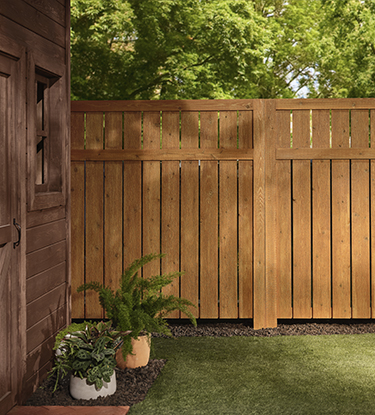Raise Your Deck's Look with Deck Staining Franklin
Wiki Article
Necessary Tips for Deck Discoloration Success
Accomplishing a faultlessly tarnished deck calls for more than just a brush and a can of stain. From choosing the best kind of tarnish to mastering the art of application, each stage plays a critical duty in the last outcome.Selecting the Right Stain
Choosing the proper tarnish is vital in attaining a long lasting and visually pleasing surface for your deck. fence staining near me. When choosing a discolor for your deck, it is necessary to consider aspects such as the wood kind, desired shade, level of defense needed, and maintenance choices
First of all, consider the kind of timber your deck is made from, as different wood species may react differently to particular kinds of spots. Woods like oak or mahogany may need various spots compared to softwoods like yearn or cedar. Comprehending the characteristics of the timber will help you select a stain that permeates properly and enhances its natural appeal.
Next, consider the color you want for your deck. Discolorations come in a range of shades, from all-natural tones that boost the wood's grain to even more nontransparent shades that give much better UV security. Choose a color that complements your exterior space and matches your visual preferences.
Furthermore, analyze the level of security the discolor offers. Some discolorations provide extra extensive protection versus UV rays, wetness, and mold, which can prolong the life of your deck. Stabilizing protection with visual appeals is essential to accomplishing a resilient and visually attractive finish.
Preparing the Deck Surface Area
To make sure an effective application of the selected discolor, complete preparation of the deck surface area is crucial. Use a deck cleaner or timber brightener along with a stiff-bristled brush to scrub the surface tidy.Check the deck for any damaged or rotten boards. Change or fix these as needed to guarantee the architectural integrity of the deck. Sanding the surface area might be necessary to smooth out harsh locations and get rid of any loosened wood fibers. fence staining near me. This action not just assists the tarnish stick much better yet additionally improves the overall appearance of the deck.
Using the Discoloration Correctly

Begin by completely mixing the stain to make sure an even uniformity. Utilize a paint stirrer to mix the tarnish well, specifically if it has actually been sitting for a while. When applying the stain, use a paintbrush, sprayer, or roller , depending upon the sort of stain and the size of the deck. Work in workable sections to stop the tarnish from drying unevenly. Use the stain in the instructions of the wood grain to make certain even coverage and an expert coating.
Enable the very first layer to dry totally prior to choosing if a 2nd layer is necessary. Adhere to the maker's guidelines concerning drying times and reapplication. Proper application of the stain is essential for protecting your deck and improving its appearance for years to find.
Preserving Your Tainted Deck
After effectively applying the stain to your deck, preserving its look and safety qualities is critical for lasting longevity and visual charm. Regular maintenance is crucial to maintaining the charm and stability of your discolored deck. Resolving issues immediately can avoid them from intensifying and extend the life of your stained deck.

Troubleshooting Common Issues
Recognizing and addressing common concerns that may emerge with your discolored deck is crucial for guaranteeing its durability and optimum efficiency. One typical trouble is flaking or hill fence company peeling of the tarnish. This can happen as a result of bad adhesion brought on by insufficient surface area prep work or using the stain in undesirable weather problems. To correct this, the influenced areas need to be stripped, fined sand, and correctly re-stained complying with manufacturer guidelines.One more concern commonly experienced is mold and mildew and mildew development on the deck surface area. This can be credited to moisture retention, lack of sunshine, or improper air flow. To tackle this problem, a comprehensive cleaning with a mold and mildew and mold eliminator adhered to by proper drying out and application of a mold-resistant tarnish is important.
Moreover, fading of the tarnish shade in time is a widespread issue. UV direct exposure and rough weather condition can trigger staining. To address this, selecting a top quality, UV-resistant discolor and applying a fresh layer occasionally can help preserve the deck's visual charm.

Verdict
Finally, effective deck staining calls for selecting the appropriate stain, correctly preparing the deck surface, applying the stain appropriately, and keeping the discolored deck. By complying with these vital suggestions, you can achieve a perfectly discolored deck that improves the general look of your outside space. Keep in mind to fix any usual concerns that may emerge throughout the read what he said discoloration process to make sure a visually attractive and resilient result.Accomplishing a flawlessly stained deck needs even more than simply a brush and a can of discolor.To guarantee a successful application of the chosen stain, complete prep work of the deck surface area is vital. When using the stain, make use of a paintbrush, sprayer, or roller , depending on the type of tarnish and my latest blog post the dimension of the deck.Identifying and dealing with common issues that may develop with your tarnished deck is essential for ensuring its durability and ideal efficiency.In final thought, effective deck staining requires selecting the right tarnish, appropriately preparing the deck surface, using the stain correctly, and keeping the stained deck.
Report this wiki page